How much money does a person working in Information Technology make in Oman?

Average Monthly Salary
1,820 OMR
( 21,900 OMR yearly)
LOW
920
OMR
AVERAGE
1,820
OMR
HIGH
2,900
OMR
All salary figures displayed here are per month except when noted otherwise.
All salary and compensation figures displayed here are gross salary figures, that is the salary before tax deductions. Because taxes may differ across sectors and locations, it is difficult to accurately calculate the net salary after tax for every career.
A person working in Information Technology in Oman typically earns around 1,820 OMR. Salaries range from 920 OMR (lowest average) to 2,900 OMR (highest average, actual maximum salary is higher).
Salary Variance
The provided figure represents the median compensation that encompasses housing, transportation, and other perks. The salaries within the Information Technology domain in Oman exhibit significant discrepancies across various professions. In case you seek information about the remuneration of a specific position, please refer to the salaries listed below for respective job titles.
Salaries for specific jobs
| Information Technology | |
| 2nd Line Systems Engineer | 1,640 OMR |
| A/B Testing Specialist | 1,420 OMR |
| ABAP Developer | 1,510 OMR |
| Advertising Account Planner | 1,540 OMR |
|
| Amazon Web Services Specialist | 2,050 OMR |
| Android Developer | 1,710 OMR |
| Angular Developer | 1,500 OMR |
| Angular JS Programmer | 1,570 OMR |
| Application Consultant | 2,100 OMR |
| Application Developer | 1,760 OMR |
| Application Management Analyst | 1,690 OMR |
| Applications Engineer | 1,390 OMR |
| Applications Support | 1,190 OMR |
| Applications System Specialist | 1,540 OMR |
| Artificial Intelligence / Machine Learning Analyst | 1,860 OMR |
| Artificial Intelligence / Machine Learning Developer | 1,700 OMR |
| Artificial Intelligence / Machine Learning Ethics Officer | 2,180 OMR |
| Artificial Intelligence / Machine Learning Governance Specialist | 2,320 OMR |
| Artificial Intelligence / Machine Learning Implementation Officer | 2,250 OMR |
| Artificial Intelligence / Machine Learning Lead | 2,510 OMR |
| Artificial Intelligence / Machine Learning Officer | 2,370 OMR |
| Artificial Intelligence / Machine Learning Prompt Specialist | 1,680 OMR |
| Artificial Intelligence / Machine Learning Research Scientist | 2,270 OMR |
| Artificial Intelligence / Machine Learning Sales | 1,810 OMR |
| Artificial Intelligence / Machine Learning Software Engineer | 1,920 OMR |
| Artificial Intelligence / Machine Learning Strategist | 2,480 OMR |
| Artificial Intelligence / Machine Learning Trainer | 1,720 OMR |
| Artificial Intelligence and Machine Learning Specialist | 1,950 OMR |
| Artificial Intelligence Developer | 2,080 OMR |
| AS400 Programmer | 1,770 OMR |
| Assembly Developer | 1,780 OMR |
| Assistant Information Technology Manager | 2,010 OMR |
| Assistant Information Technology Project Manager | 2,070 OMR |
| Assistant Service Delivery Manager | 1,960 OMR |
| Avaloq Developer | 1,560 OMR |
| Back End Developer | 1,740 OMR |
| Big Data Architect | 2,010 OMR |
| BigQuery Specialist | 2,050 OMR |
| BizTalk Developer | 1,730 OMR |
| Blockchain Associate | 1,680 OMR |
| Blockchain Developer | 1,520 OMR |
| Blockchain Engineer | 1,750 OMR |
| Build and Release Engineer | 1,510 OMR |
| Business Intelligence Analyst | 1,860 OMR |
| Business Intelligence Consultant | 2,280 OMR |
| Business Intelligence Developer | 1,750 OMR |
| Business Intelligence Manager | 2,480 OMR |
| Business Objects Developer | 1,530 OMR |
| Business Process Analyst | 1,850 OMR |
| Business Process Consultant | 1,810 OMR |
| Business Systems Analyst | 1,540 OMR |
| C Developer | 1,830 OMR |
| C# Developer | 1,720 OMR |
| C++ Developer | 1,850 OMR |
| Capacity Planning Manager | 2,330 OMR |
| Cassandra Specialist | 1,760 OMR |
| Change Administrator | 1,500 OMR |
| Chatbot Developer | 1,560 OMR |
| ChatGPT Expert | 1,490 OMR |
| Chief Artificial Intelligence Officer | 2,840 OMR |
| Chief Cloud Officer | 2,540 OMR |
| Chief Data Governance Officer | 2,530 OMR |
| Chief Data Officer | 2,480 OMR |
| Chief Digital Ethics Officer | 2,260 OMR |
| Chief Digital Officer | 2,630 OMR |
| Chief Information Officer | 2,780 OMR |
| Chief Information Security Officer | 2,470 OMR |
| Chief Innovation Officer | 2,400 OMR |
| Chief Privacy Officer | 2,000 OMR |
| Client Delivery Manager | 2,220 OMR |
| Clojure Developer | 2,150 OMR |
| Cloud Compliance Architect | 1,690 OMR |
| Cloud Computing Specialist | 1,850 OMR |
| Cloud Infrastructure Engineer | 1,750 OMR |
| Cloud Migration Specialist | 1,820 OMR |
| Cloud Security Architect | 1,680 OMR |
| Cloud Services Engineer | 1,670 OMR |
| Cloud Solutions Architect | 1,890 OMR |
| Cloud-Based Inventory Manager | 1,770 OMR |
| CMS Developer | 1,350 OMR |
| Computer Animator | 1,490 OMR |
| Computer Engineer | 1,400 OMR |
| Computer Hardware Engineer | 1,350 OMR |
| Computer Network Support Specialist | 1,620 OMR |
| Computer Networks Architect | 1,690 OMR |
| Computer Operator | 1,120 OMR |
| Computer Programmer | 1,730 OMR |
| Computer Security Specialist | 1,960 OMR |
| Computer Support Specialist | 1,350 OMR |
| Computer Technician | 1,370 OMR |
| Computer Virtualization Implementation Specialist | 1,730 OMR |
| Copy Editor | 1,410 OMR |
| Cosmos DB Specialist | 1,640 OMR |
| Couch DB Specialist | 1,650 OMR |
| CRM Application Administrator | 1,550 OMR |
| CRM Manager | 1,700 OMR |
| Cross Platform Security Manager | 2,200 OMR |
| Curam Developer | 1,350 OMR |
| Cyber Security Consultant | 2,020 OMR |
| Cyber Security Researcher | 2,020 OMR |
| Cyber Security Specialist | 1,930 OMR |
| Cybersecurity Analyst | 1,930 OMR |
| Cybersecurity Architect | 1,860 OMR |
| Cybersecurity Compliance Specialist | 1,570 OMR |
| Cybersecurity Engineer | 1,780 OMR |
| Cybersecurity Manager | 2,350 OMR |
| Dart Developer | 1,260 OMR |
| Data Analyst | 1,530 OMR |
| Data Analytics Engineer | 1,610 OMR |
| Data Architect | 1,740 OMR |
| Data Center Specialist | 1,730 OMR |
| Data Center Technician | 1,450 OMR |
| Data Entry Coordintor | 910 OMR |
| Data Entry Supervisor | 1,080 OMR |
| Data Governance Manager | 2,390 OMR |
| Data Management Specialist | 1,920 OMR |
| Data Manager | 2,180 OMR |
| Data Modeling Analyst | 1,610 OMR |
| Data Privacy and Protection Manager | 2,070 OMR |
| Data Quality Analyst | 1,650 OMR |
| Data Security Analyst | 1,700 OMR |
| Data Security Manager | 2,400 OMR |
| Data Technician | 1,030 OMR |
| Data Visualisation Analyst | 1,670 OMR |
| Data Visualization Specialist | 1,640 OMR |
| Data Warehousing Manager | 2,300 OMR |
| Data Warehousing Specialist | 1,570 OMR |
| Data-driven Designer | 1,520 OMR |
| Database Administration Manager | 2,090 OMR |
| Database Administrator | 1,660 OMR |
| Database Analyst | 1,830 OMR |
| Database Developer | 1,720 OMR |
| Database Report Writer | 1,540 OMR |
| Deep Learning Developer | 1,710 OMR |
| Delivery Manager | 1,780 OMR |
| Delphi Developer | 1,800 OMR |
| Desktop Support Engineer | 1,130 OMR |
| Desktop Support Technician | 1,140 OMR |
| Desktop Virtualization Engineer | 1,370 OMR |
| Developer / Programmer | 1,650 OMR |
| Developer Evangelist | 1,620 OMR |
| Development Architect | 1,610 OMR |
| Development Group Supervisor | 1,870 OMR |
| Development Manager | 2,250 OMR |
| DevOps Engineer | 1,720 OMR |
| Digital Ethics Consultant | 1,890 OMR |
| Digital Forensics Expert | 1,690 OMR |
| Director of Application Development | 2,500 OMR |
| Director of Technology | 2,920 OMR |
| Disaster Recovery Analyst | 1,550 OMR |
| Disaster Recovery Specialist | 1,640 OMR |
| Django Specialist | 1,590 OMR |
| Documentation Specialist | 1,420 OMR |
| Driver Developer | 1,750 OMR |
| E-Commerce Manager | 2,130 OMR |
| E-Commerce Marketing Analyst | 1,970 OMR |
| E-Commerce Marketing Manager | 2,060 OMR |
| E-Commerce Sales Manager | 2,280 OMR |
| E-Commerce Strategy Manager | 2,330 OMR |
| E-waste Recycling Specialist | 1,500 OMR |
| E-waste Technician | 1,320 OMR |
| Edge Computing Engineer | 1,550 OMR |
| Elixir Developer | 2,140 OMR |
| Embedded Software Developer | 1,800 OMR |
| Enterprise Architecture Manager | 2,180 OMR |
| Enterprise Infrastructure Architect | 2,230 OMR |
| Enterprise Infrastructure Manager | 2,570 OMR |
| Erlang Developer | 2,210 OMR |
| ERP / CRM Technical Consultant | 1,840 OMR |
| ERP Analyst | 1,780 OMR |
| ERP Project Manager | 2,170 OMR |
| Ethical Hacker | 1,490 OMR |
| Financial Systems Manager | 2,510 OMR |
| Firebird Specialist | 1,600 OMR |
| Flash Developer | 1,510 OMR |
| Front End Developer | 1,460 OMR |
| Front End Web Developer | 1,410 OMR |
| Full Stack Developer | 1,690 OMR |
| Functional Analyst | 1,810 OMR |
| Game Developer | 1,480 OMR |
| GIS Analyst | 1,560 OMR |
| GIS Developer | 1,710 OMR |
| Global BI Analyst | 1,720 OMR |
| Go Developer | 2,190 OMR |
| Google Cloud Specialist | 2,060 OMR |
| Graphical User Interface ( GUI ) Programmer | 1,480 OMR |
| Graphics Programmer | 1,450 OMR |
| Graphics Web Designer | 1,360 OMR |
| Groovy Developer | 1,940 OMR |
| Hardware Design Engineer | 1,550 OMR |
| Hardware Engineering Manager | 2,390 OMR |
| Hardware Technician | 1,320 OMR |
| Haskell Developer | 1,820 OMR |
| Head of Development | 2,250 OMR |
| Head of Information Technology | 2,720 OMR |
| Help Desk Analyst | 1,630 OMR |
| Help Desk Manager | 1,850 OMR |
| Help Desk Support | 1,210 OMR |
| Help Desk Technician | 1,150 OMR |
| Helpdesk Manager | 1,990 OMR |
| IBM DB2 Specialist | 1,500 OMR |
| Imaging Programmer | 1,430 OMR |
| InfluxDB Specialist | 1,540 OMR |
| Informatics Optimization Specialist | 1,700 OMR |
| Information Assurance Analyst | 1,770 OMR |
| Information Program Director | 2,390 OMR |
| Information Security Administrator | 1,870 OMR |
| Information Security Analyst | 1,980 OMR |
| Information Security Associate | 1,660 OMR |
| Information Security Director | 2,350 OMR |
| Information Security Engineer | 1,590 OMR |
| Information Security Manager | 2,350 OMR |
| Information Security Specialist | 2,060 OMR |
| Information Services Consultant | 2,030 OMR |
| Information Systems Developer | 1,610 OMR |
| Information Systems Manager | 2,670 OMR |
| Information Systems Penetration Testing Specialist | 1,980 OMR |
| Information Systems Vulnerability Assessment Specialist | 1,930 OMR |
| Information Technology Administrator | 1,370 OMR |
| Information Technology Analyst | 1,610 OMR |
| Information Technology Architect | 1,740 OMR |
| Information Technology Asset Manager | 2,180 OMR |
| Information Technology Business Analyst | 1,700 OMR |
| Information Technology Compliance Manager | 2,320 OMR |
| Information Technology Consultant | 1,980 OMR |
| Information Technology Coordinator | 1,400 OMR |
| Information Technology Director | 2,970 OMR |
| Information Technology Engineer | 1,460 OMR |
| Information Technology Executive | 2,340 OMR |
| Information Technology Helpdesk | 1,160 OMR |
| Information Technology Infrastructure Engineer | 1,460 OMR |
| Information Technology Manager | 2,870 OMR |
| Information Technology Operation Engineer | 1,390 OMR |
| Information Technology Operations Manager | 2,590 OMR |
| Information Technology Product Manager | 2,430 OMR |
| Information Technology Project Administrator | 1,430 OMR |
| Information Technology Project Coordinator | 1,810 OMR |
| Information Technology Project Leader | 2,010 OMR |
| Information Technology Project Manager | 2,480 OMR |
| Information Technology Quality Assurance Manager | 2,030 OMR |
| Information Technology Quality Assurance Team Lead (QA) | 1,780 OMR |
| Information Technology Quality Specialist | 1,670 OMR |
| Information Technology Risk Manager | 2,620 OMR |
| Information Technology Sales Manager | 2,340 OMR |
| Information Technology Specialist | 1,980 OMR |
| Information Technology Staff | 1,250 OMR |
| Information Technology Support | 1,170 OMR |
| Information Technology Systems Analyst | 1,790 OMR |
| Information Technology Team Leader | 2,110 OMR |
| Information Technology Trainer | 1,680 OMR |
| Information Technology Training Analyst | 1,680 OMR |
| Interface Design Manager | 2,190 OMR |
| Interface Designer | 1,400 OMR |
| IOS Developer | 1,800 OMR |
| Java Developer | 1,880 OMR |
| Javascript Developer | 1,660 OMR |
| jQuery Specialist | 1,610 OMR |
| Kotlin Developer | 1,960 OMR |
| Laravel Specialist | 1,610 OMR |
| Lead Developer | 1,910 OMR |
| Linux Administrator | 1,640 OMR |
| Lisp Developer | 2,130 OMR |
| Lotus Domino Administrator | 1,800 OMR |
| Lotus Notes Developer | 1,650 OMR |
| Lua Developer | 1,990 OMR |
| Mail Server Administrator | 1,590 OMR |
| Major Incident Manager | 1,970 OMR |
| Malware Analysis Expert | 1,910 OMR |
| Managed Service Specialist | 1,730 OMR |
| MariaDB Specialist | 1,620 OMR |
| MATLAB Developer | 1,830 OMR |
| Microsoft Azure Specialist | 1,940 OMR |
| Microsoft SQL Server Specialist | 1,880 OMR |
| Microsystems Engineer | 1,670 OMR |
| Mobile Developer | 1,750 OMR |
| Mobile Interface Designer | 1,650 OMR |
| MongoDB Specialist | 1,720 OMR |
| Multimedia Developer | 1,460 OMR |
| Multimedia Services Manager | 1,840 OMR |
| MySQL Specialist | 1,580 OMR |
| Neo4J Specialist | 1,600 OMR |
| Network Administration Team Lead | 2,030 OMR |
| Network Administrator | 1,490 OMR |
| Network Analyst | 1,520 OMR |
| Network and Infrastructure Manager | 2,580 OMR |
| Network Engineer | 1,550 OMR |
| Network Engineering Manager | 1,950 OMR |
| Network Security Systems Manager | 2,000 OMR |
| Network Specialist | 1,690 OMR |
| Network Support Engineer | 1,320 OMR |
| Network Support Specialist | 1,430 OMR |
| Network Technician | 1,280 OMR |
| Neural Network Engineer | 1,900 OMR |
| NextJs Specialist | 1,580 OMR |
| Nodejs Developer | 1,780 OMR |
| NT Systems Administrator | 1,510 OMR |
| Numerical Control Programmer | 1,400 OMR |
| Objective-C Developer | 1,890 OMR |
| Online Banking Manager | 2,620 OMR |
| Online Banking Specialist | 2,080 OMR |
| OPS Manager | 2,260 OMR |
| Oracle Database Administrator | 1,620 OMR |
| Oracle Database Specialist | 1,990 OMR |
| Oracle Developer | 1,730 OMR |
| Perl Developer | 1,370 OMR |
| PHP Developer | 1,520 OMR |
| PostgreSQL Specialist | 1,770 OMR |
| PowerShell Developer | 1,630 OMR |
| Principal Consultant | 1,800 OMR |
| Principal Data Engineer | 1,650 OMR |
| Program Lead | 2,040 OMR |
| Python Developer | 1,850 OMR |
| R Language Developer | 1,940 OMR |
| React Specialist | 1,780 OMR |
| Records Manager | 1,440 OMR |
| Redis Specialist | 1,490 OMR |
| Remedy Developer | 1,380 OMR |
| Reporting Analyst | 1,600 OMR |
| Reverse Engineering Expert | 1,840 OMR |
| Robotic Process Automation Compliance Analyst | 1,560 OMR |
| Robotic Process Automation Developer | 1,440 OMR |
| Ruby Developer | 1,610 OMR |
| Rust Developer | 2,070 OMR |
| Salesforce Administrator | 1,530 OMR |
| Salesforce Developer | 1,350 OMR |
| SAP Consultant | 1,830 OMR |
| SAS Programmer | 1,530 OMR |
| Scala Developer | 2,100 OMR |
| Scrum Master | 1,420 OMR |
| SEO Associate | 1,450 OMR |
| SEO Manager | 2,050 OMR |
| Server Virtualization Consultant | 2,130 OMR |
| Service Delivery Manager | 2,220 OMR |
| Service Level Manager | 2,160 OMR |
| Service Support Lead | 1,620 OMR |
| SharePoint Administrator | 1,580 OMR |
| Sharepoint Consultant | 1,690 OMR |
| Sharepoint Developer | 1,740 OMR |
| Shift Leader | 1,750 OMR |
| Snowflake Specialist | 1,660 OMR |
| SOA Analyst | 1,630 OMR |
| SOC Engineer | 1,660 OMR |
| Software Analyst | 1,660 OMR |
| Software Architect | 1,570 OMR |
| Software Automation Engineer | 1,720 OMR |
| Software Developer | 1,650 OMR |
| Software Development Manager | 2,300 OMR |
| Software Engineer | 1,700 OMR |
| Software QA Engineer | 1,540 OMR |
| Software Sales | 1,440 OMR |
| Software Specialist | 1,500 OMR |
| Software Support Engineer | 1,370 OMR |
| Software Test Engineer | 1,400 OMR |
| Software Tester | 1,480 OMR |
| Solutions Architect | 2,170 OMR |
| Solutions Consultant | 1,860 OMR |
| SQLite Specialist | 1,550 OMR |
| Storage Engineer | 1,370 OMR |
| Supabase Specialist | 1,330 OMR |
| Supervisor | 1,180 OMR |
| Support Analyst | 1,500 OMR |
| Support Specialist | 1,680 OMR |
| Support Team Leader | 1,510 OMR |
| Swift Developer | 2,050 OMR |
| System Administrator | 1,450 OMR |
| Systems Analyst | 1,590 OMR |
| Systems Architect | 1,740 OMR |
| Systems Consultant | 1,960 OMR |
| Systems Engineer | 1,340 OMR |
| Systems Integration Analyst | 1,660 OMR |
| Systems Integration Specialist | 2,270 OMR |
| Systems Integrator | 1,720 OMR |
| Technical Analyst | 1,510 OMR |
| Technical Consultant | 1,970 OMR |
| Technical Manager | 1,770 OMR |
| Technical Project Manager | 2,200 OMR |
| Technical Sales | 1,650 OMR |
| Technical Trainer | 1,670 OMR |
| Technical Writer | 1,560 OMR |
| Technology Business Analyst | 1,780 OMR |
| Technology Director | 2,790 OMR |
| Technology Specialist | 2,030 OMR |
| Technology Vice President | 2,230 OMR |
| Teradata Developer | 1,430 OMR |
| Test Analyst | 1,560 OMR |
| Tester | 1,410 OMR |
| Testing Manager | 2,320 OMR |
| TIBCO Developer | 1,480 OMR |
| TypeScript Developer | 1,960 OMR |
| UI Engineer | 1,560 OMR |
| UNIX Administrator | 1,730 OMR |
| Usability Engineer | 1,630 OMR |
| User Experience Consultant | 1,690 OMR |
| User Experience Design Expert | 1,720 OMR |
| User Experience Designer | 1,520 OMR |
| User Experience Researcher | 1,840 OMR |
| User Interface Designer | 1,610 OMR |
| User Support Engineer | 1,370 OMR |
| VB Developer | 1,280 OMR |
| VB.NET Developer | 1,790 OMR |
| Video Game Designer | 1,390 OMR |
| Virtual / Augmented Reality Architect | 2,040 OMR |
| Virtual / Augmented Reality Compliance Specialist | 1,920 OMR |
| Virtual / Augmented Reality Consultant | 2,310 OMR |
| Virtual / Augmented Reality Designer | 2,310 OMR |
| Virtual / Augmented Reality Developer | 1,970 OMR |
| Virtual / Augmented Reality Director | 2,270 OMR |
| Virtual / Augmented Reality Engineer | 2,040 OMR |
| Virtual / Augmented Reality Filmmaker | 2,300 OMR |
| Virtual / Augmented Reality Game Developer | 2,000 OMR |
| Virtual / Augmented Reality Marketing Specialist | 2,050 OMR |
| Virtual / Augmented Reality Officer | 2,310 OMR |
| Virtual / Augmented reality Sales Consultant | 2,400 OMR |
| Virtual / Augmented Reality Simulator Operator | 1,710 OMR |
| Virtual / Augmented Reality Specialist | 2,020 OMR |
| Virtual / Augmented Reality Technician | 1,660 OMR |
| Virtual / Augmented Reality Trainer | 2,370 OMR |
| Virtual / Augmented Reality User Experience Designer | 1,770 OMR |
| Visual Basic Developer | 1,280 OMR |
| Visual Information Specialist | 1,610 OMR |
| Voice Interface Designer | 1,390 OMR |
| VueJs Specialist | 1,630 OMR |
| Web Applications Manager | 1,940 OMR |
| Web Content Specialist | 1,780 OMR |
| Web Designer | 1,550 OMR |
| Web Developer | 1,510 OMR |
| Web Editor | 1,350 OMR |
| Web Project Manager | 1,790 OMR |
| Web Promotions Specialist | 1,710 OMR |
| Web Security Administrator | 1,710 OMR |
| Web Security Manager | 2,380 OMR |
| Web Support Analyst | 1,300 OMR |
| Web Writer | 1,380 OMR |
| Webmaster | 1,390 OMR |
| Windows System Administrator | 1,490 OMR |
| Wireless Consultant | 2,010 OMR |
| WordPress Specialist | 1,670 OMR |
| Writer and Documentor | 1,520 OMR |
| Zig Developer | 2,170 OMR |

Information Technology Jobs Pay Scale and Salaries in Oman
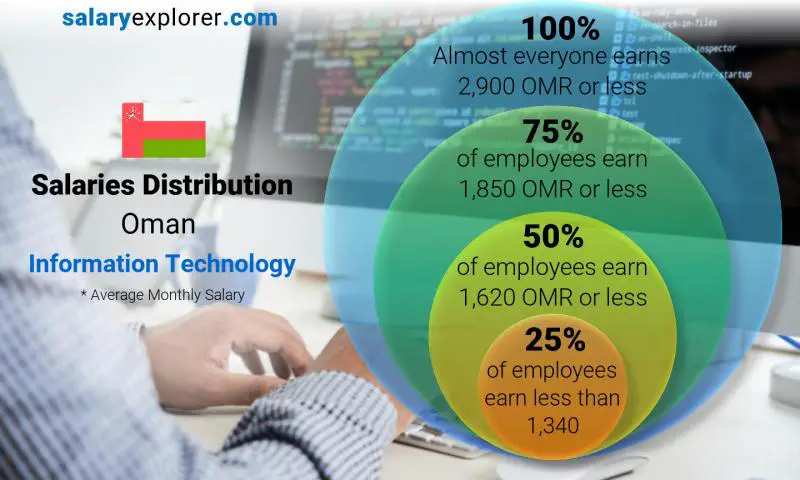
Share This Chart Get Chart Linkhttp://www.salaryexplorer.com/charts/oman/information-technology/median-and-salary-distribution-monthly-oman-information-technology.jpg Salary Structure and Pay Scale Comparison
5% of people earn
1,640 OMR or more
10% of people earn
1,450 to 1,640 OMR
20% of people earn
1,040 OMR or less
65% of people earn
1,040 to 1,450 OMR
Minimum Salary
920 OMR |
Median
1,620 OMR |
Maximum
2,900 OMR |
Median Salary, maximum and minimum salary, minimum wage, starting salary, and the salary range
All salary figures displayed here are per month except when noted otherwise.
Salary Range, Minimum Wage, and Starting Salary
Salaries in Information Technology in Oman range from 920 OMR (starting average salary) to 2,900 OMR (maximum average salary, actual maximum is higher). To clarify, the number presented is not the legally mandated minimum wage. Rather, it represents the lowest figure reported in a salary survey that involved thousands of participants and professionals from across the entire country.
Median Salary
The median income in the field of Information Technology is 1,620 OMR, implying that half of the workforce in Oman earns less than this figure, and the other half earns more. It represents the central value of salaries. As a rule of thumb, you would prefer to be part of the group earning above the median wage, situated on the right-hand side of the salary distribution chart.
Percentiles and Salary Scale
Two values that are highly correlated with the median are the 25th and 75th percentiles. By examining the salary distribution diagram, it is possible to determine that 25% of individuals employed in Information Technology in Oman earn less than 1,340 OMR, while 75% of them earn more. Additionally, the diagram reveals that 75% of individuals earn less than 1,850 OMR, while 25% earn more than that.
Pay Scale Structure
Data was regrouped into brackets to provide a better understanding of what salaries can be expected. This approach was deemed more accurate than relying solely on the average salary, as it offers greater insights into the distribution of salaries in the field of Information Technology in Oman. The analysis revealed that roughly 65% of all reported salaries fell within the range of 1,040 OMR to 1,450 OMR. Approximately 20% of salaries were below the 1,040 OMR mark, while 10% ranged from 1,450 OMR to 1,640 OMR. Only 5% of individuals earned a gross salary of 1,640 OMR or higher.
Salary Comparison by Years of Experience
How does a person's salary progress over time?
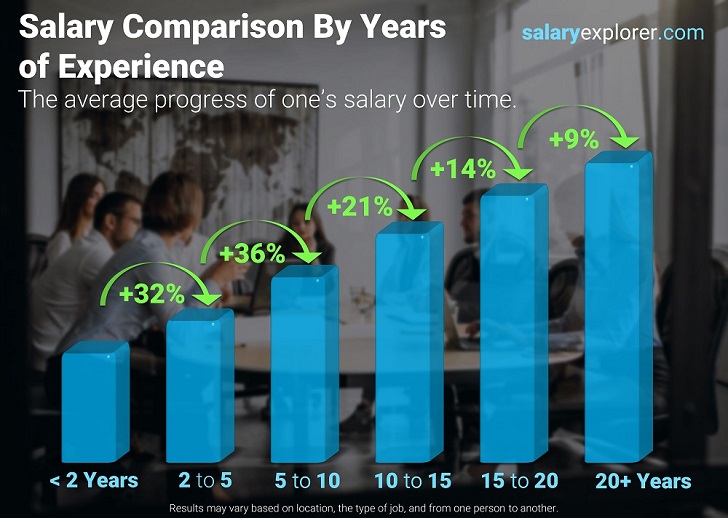
Share This Chart Get Chart Linkhttp://www.salaryexplorer.com/images/salary-by-experience.jpg The experience level is the most important factor in determining the salary. Naturally, the more years of experience the higher the wage.
Generally speaking, employees in Information Technology in Oman having experience from two to five years earn on average 32% more than freshers and juniors across all industries and disciplines.
Professionals with experience of more than five years tend to earn on average 36% more than those with five years or less of work experience.
As you hit the ten years mark, the salary increases by 21% and an additional 14% for those who have crossed the 15 years mark.
Those figures are presented as guidelines only. The numbers become more significant if you consider one job title at a time.
Change in salary based on experience varies drastically from one location to another and depends hugely on the career field as well. The data displayed here is the combined average of many different jobs. To view accurate figures, choose a specific job title.
“ On average, a person's salary doubles their starting salary by the time they cross the 10 years* experience mark. ”
Salary Comparison By Education
How does the education level affect your salary?
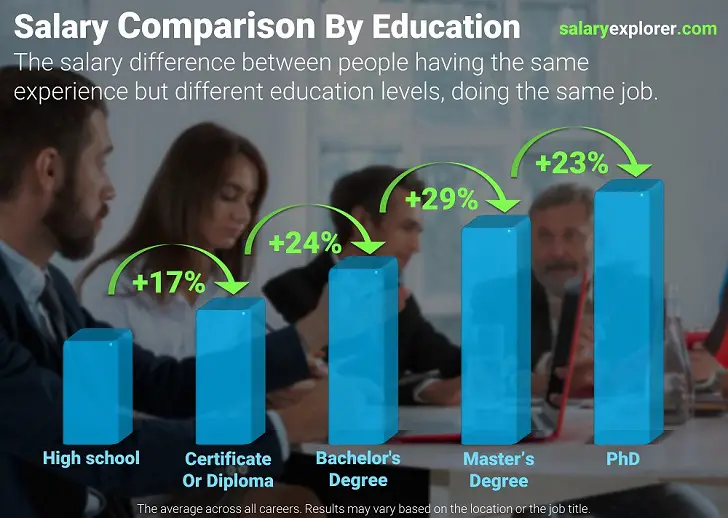
Share This Chart Get Chart Linkhttp://www.salaryexplorer.com/images/salary-comparison-by-education.jpg Change in salary based on education varies drastically from one location to another and depends hugely on the career field as well. The data displayed here is the combined average of multiple jobs. To view accurate figures, choose a specific job title.
It is well known that higher education equals a bigger salary, but how much more money can a degree add to your income?
We compared the salaries of professionals at the same level but with different college degree levels across many jobs in Information Technology in Oman, below are our findings.
Workers with a certificate or diploma earn on average 17% more than their peers who only reached the high school level.
Employees who earned a Bachelor's Degree earn 24% more than those who only managed to attain a certificate or diploma.
Professionals who attained a Master's Degree are awarded salaries that are 29% more than those with a Bachelor's Degree.
Finally, PhD holders earn 23% more than Master's Degree holders on average while doing the same job.
Is a Master's degree or an MBA worth it? Should you pursue higher education?
A Master's degree program or any post-graduate program in Oman costs anywhere from 8,880 OMR to 26,600 OMR and lasts approximately two years. That is quite an investment.
Employees can't expect any salary increases during the study period, assuming they already have a job. In most cases, a salary review is conducted once education is completed and the degree has been attained.
Many people pursue higher education as a tactic to switch to a higher-paying job. The numbers seem to support this tactic. The average increase in compensation while changing jobs is approximately 10% more than the customary salary increment.
The decision really depends on the situation and experience among many other factors. Putting all variables aside, if a person can afford the costs of higher education then the return on investment is definitely worth it. Degree costs can be recovered roughly in a year or so.
Salary and Compensation Comparison By Gender / Information Technology / Oman
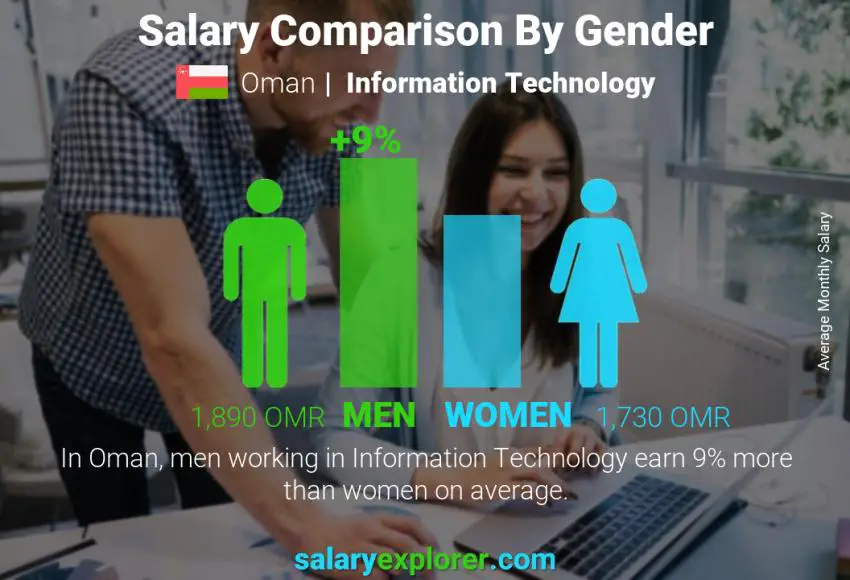
Share This Chart Get Chart Linkhttp://www.salaryexplorer.com/charts/oman/information-technology/salary-comparison-by-gender-monthly-oman-information-technology.jpg Though gender should not have an effect on pay, in reality, it does. So who gets paid more: men or women? In the field of Information Technology in Oman, the average difference between the salary of male and female employees is 9%.
| Male | | 1,890 OMR |
| Female | -8% | 1,730 OMR |
Percentage increase and decrease are relative to the previous value
Salary Comparison By Gender in Oman for all Careers
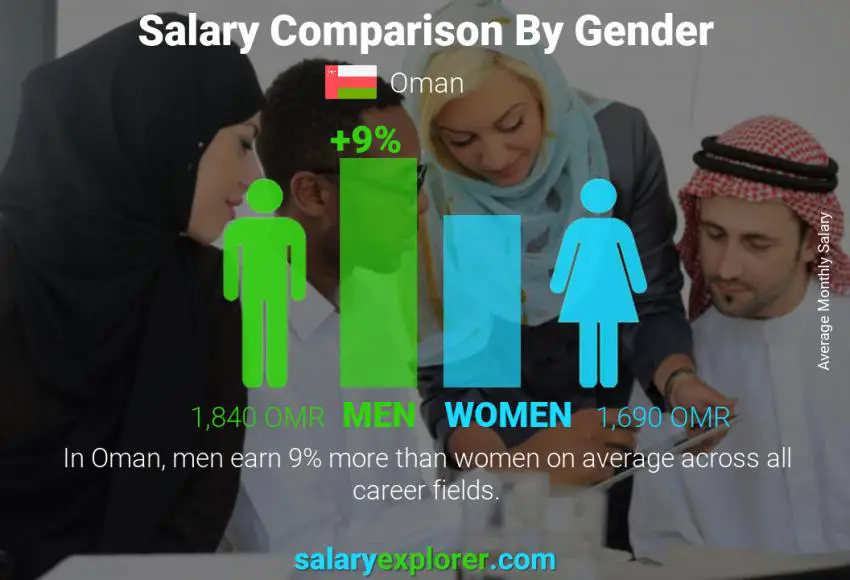
Share This Chart Get Chart Linkhttp://www.salaryexplorer.com/charts/oman/salary-comparison-by-gender-monthly-oman.jpg
Average Annual Salary Increment Percentage / Information Technology / Oman
How much are annual salary increments in Oman for individuals working in Information Technology? How often do employees get salary raises?
Professionals working in Information Technology in Oman are likely to observe a salary increase of approximately 8% every 18 months. The national average annual increment for all professions combined is 7% granted to employees every 19 months.
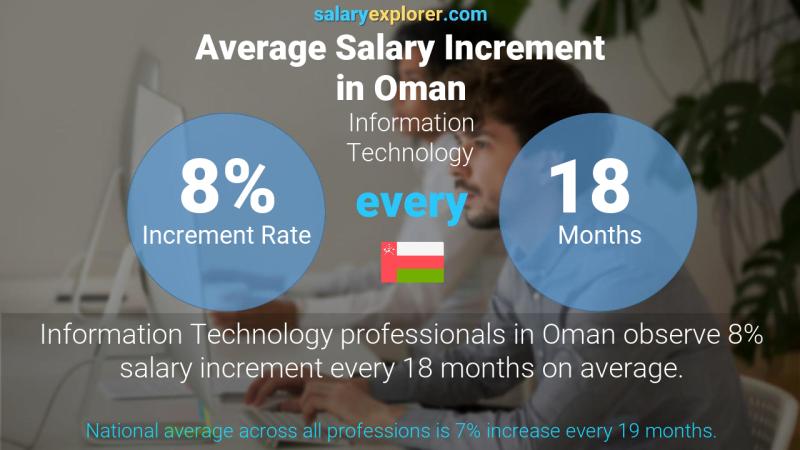
Share This Chart Get Chart Linkhttp://www.salaryexplorer.com/charts/oman/information-technology/annual-salary-increment-rate-oman-information-technology.jpg The figures provided here are averages of numbers. Those figures should be taken as general guidelines. Salary increments will vary from person to person and depend on many factors, but your performance and contribution to the success of the organization remain the most important factors in determining how much and how often you will be granted a raise.
Oman / All Professions

Share This Chart Get Chart Linkhttp://www.salaryexplorer.com/charts/oman/annual-salary-increment-rate-oman.jpg The term Annual Salary Increase usually refers to the increase in 12 calendar month period, but because it is rare that people get their salaries reviewed exactly on the one-year mark, it is more meaningful to know the frequency and the rate at the time of the increase.
How to calculate the salary increment percentage?
The annual salary Increase in a calendar year (12 months) can be easily calculated as follows: Annual Salary Increase = Increase Rate x 12 / Increase Frequency
“The average salary increase in one year (12 months) in Oman is 4%.”
Worldwide Salary Raises: All Countries and All Jobs
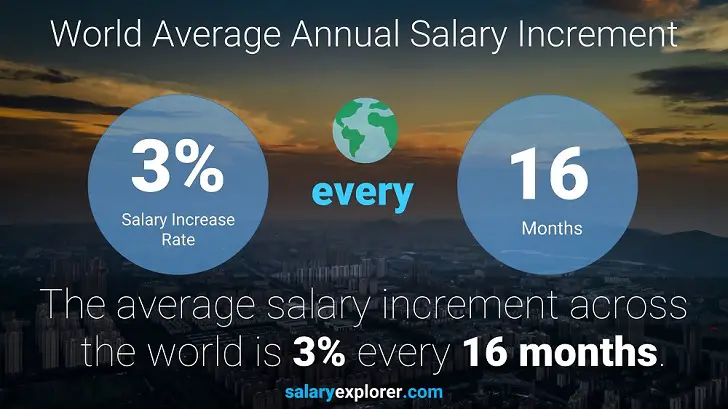
Share This Chart Get Chart Linkhttp://www.salaryexplorer.com/images/salary-increment-world.jpg Salary Packages and Schemes
Not all compensation increases are reflected directly in the salary. Some companies offer upgraded packages to their staff instead of cash money. The figures displayed here account only for direct increments to the base salary.
Bonus and Incentive Rates / Information Technology / Oman
How much and how often are bonuses being awarded?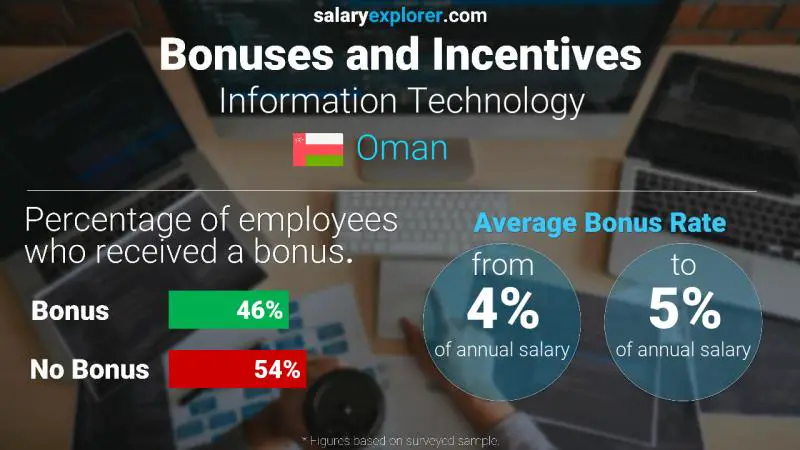
Share This Chart Get Chart Linkhttp://www.salaryexplorer.com/charts/oman/information-technology/annual-salary-bonus-rate-oman-information-technology.jpg
54% of surveyed staff in Information Technology reported that they haven't received any bonuses or incentives in the previous year while 46% said that they received at least one form of monetary bonus.
Those who got bonuses reported rates ranging from 4% to 5% of their annual salary.
| Received Bonus | | 46% |
| No Bonus | | 54% |
Types of Bonuses Considered
Individual Performance-Based BonusesThe most standard form of bonus, where the employee is awarded based on their exceptional performance.
Company Performance BonusesOccasionally, some companies like to celebrate excess earnings and profits with their staff collectively in the form of bonuses that are granted to everyone. The amount of the bonus will probably be different from person to person depending on their role within the organization.
Goal-Based BonusesGranted upon achieving an important goal or milestone.
Holiday / End of Year BonusesThese types of bonuses are given without a reason and usually resemble an appreciation token.
Bonuses Are Not Commissions!
People tend to confuse bonuses with commissions. A commission is a prefixed rate at which someone gets paid for items sold or deals completed while a bonus is in most cases arbitrary and unplanned.
What makes a position worthy of good bonuses and a high salary?
The main two types of jobs |
| Revenue Generators | Supporting Cast |
Employees that are directly involved in generating revenue or profit for the organization. Their field of expertise usually matches the type of business. | Employees that support and facilitate the work of revenue generators. Their expertise is usually different from that of the core business operations. |
Example:
A graphics designer working for a graphics designing company. | Example:
A graphic designer in the marketing department of a hospital. |
Revenue generators usually get more and higher bonuses, higher salaries, and more frequent salary increments. The reason is quite simple: it is easier to quantify your value to the company in monetary terms when you participate in revenue generation.
“Try to work for companies where your skills can generate revenue. We can't all generate revenue and that's perfectly fine.”
Bonus Comparison by Seniority Level
Top management personnel and senior employees naturally exhibit higher bonus rates and frequencies than juniors. This is very predictable due to the inherent responsibilities of being higher in the hierarchy. People in top positions can easily get double or triple bonus rates than employees down the pyramid.
Hourly Average Wage / Information Technology / Oman
 11
11 OMR
per hour The average hourly wage (pay per hour) in Information Technology in Oman is 11 OMR.This is the rate they get paid for every worked hour.
Hourly Wage = Annual Salary / ( 52 x 5 x 8 )
About The Hourly Pay Rate
The hourly wage is the salary paid in one worked hour. Usually, jobs are classified into two categories: salaried jobs and hourly jobs. Salaried jobs pay a fixed amount regardless of the hours worked. Hourly jobs pay per worked hour. To convert salary into hourly wage the above formula is used (assuming 5 working days in a week and 8 working hours per day which is the standard for most jobs). The hourly wage calculation may differ slightly depending on the worked hours per week and the annual vacation allowance. The figures mentioned above are good approximations and are considered to be the standard. One major difference between salaried employees and hourly paid employees is overtime eligibility. Salaried employees are usually exempt from overtime as opposed to hourly paid staff.
What is the minimum hourly rate of pay?
The minimum pay rate per hour for people working in Information Technology in Oman is 5 OMR. This is the minimum as per the gathered data in the salary survey not the minimum hourly rate mandated by law.
Salary Comparison By City
Government vs Private Sector Salary Comparison
Where can you get paid more, working in a private company or the government? The difference between the public or government sector salaries and the private sector salaries in Oman is 7% on average across all career fields.
| Private Sector | | 1,700 OMR |
| Public Sector | +7% | 1,830 OMR |
Percentage increase and decrease are relative to the previous value
Salary Statistics and Calculation Guide
What is considered to be a good and competitive salary in Information Technology in Oman?
A good and competitive compensation would range anywhere between 1,620 OMR and 1,850 OMR. This is a very rough estimate. Experience and education play a very huge part in the final earnings.
Gross Salary (before tax) and Net Salary (after tax)
All salary and compensation figures displayed here are gross salary figures, that is the salary before tax deductions. Because taxes may differ across sectors and locations, it is difficult to accurately calculate the net salary after tax for every career.
Base / Basic Salary
The base salary for jobs in Information Technology in Oman ranges from 920 OMR to 1,340 OMR. The base salary depends on many factors including experience and education. It is not easy to provide a figure with very little information, so take this range with a grain of salt.
What is the difference between the median and the average salary?
Both are indicators. If your salary is higher than both the average and the median then you are doing very well. If your salary is lower than both, then many people earn more than you and there is plenty of room for improvement. If your wage is between the average and the median, then things can be a bit complicated. We wrote a guide to explain all about the different scenarios. How to compare your salary












 Share This Chart Tweet Get Chart Linkhttp://www.salaryexplorer.com/charts/oman/information-technology/annual-salary-bonus-rate-oman-information-technology.jpg
Share This Chart Tweet Get Chart Linkhttp://www.salaryexplorer.com/charts/oman/information-technology/annual-salary-bonus-rate-oman-information-technology.jpg 11 OMR per hour
11 OMR per hour




